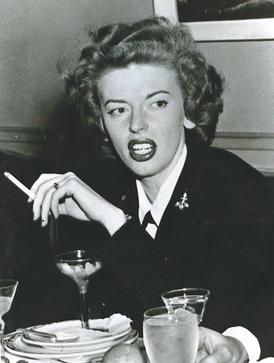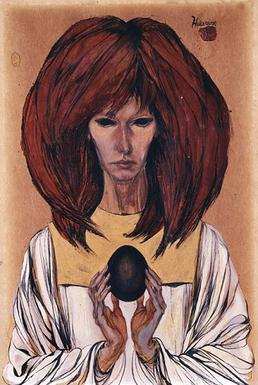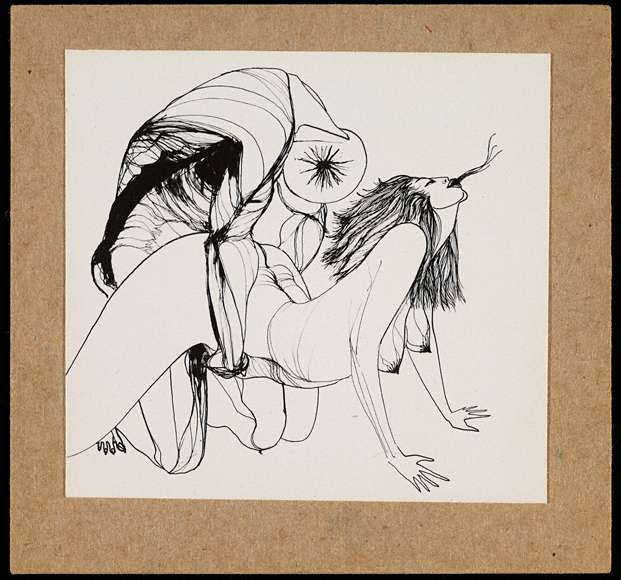
While still somewhat unknown in Pagan circles, the artist known as Cameron remains one of the most influential occult illustrators of the 20th century. Her work has been described as “Obscene Black-Magic Art” – what’s not to like? Her famous show in 1957 was shut down by obscenity charges, galvanizing her influence at the intersection of magick and art.
Cameron’s work is a unique and powerful blend of art, mysticism, and personal experience. Her paintings, drawings, and sculptures are filled with symbolism and occult imagery, and her poetry and essays explore her own spiritual journey. Cameron was a visionary artist who created a body of work that is both beautiful and challenging. Her work continues to inspire and amaze viewers. Today is also her birthday, so what better time to remember her contribution to our community?

Photo of occultist and artist Cameron, taken during the mid-1940s. [Fair use]
Born Marjorie Cameron Parsons Kimmel, she used the professional mononym of Cameron. She was born in Belle Plaine, Iowa, on April 23, 1922. Her red hair and blue eyes quickly became her hallmark. She grew up in Wisconsin and Minnesota and attended the University of Minnesota. Her family worked in the railroad industry and Chicago’s Northwest Railroad was her early playground.
“I became associated with women who were all considered antisocial for some reason or another,” Cameron said. “They were not following the chosen paths.”
Cameron was a follower of Thelema, then a relatively new religious movement established by the English occultist Aleister Crowley. She was a member of the Agape Lodge of the Ordo Templi Orientis (OTO). She was a devotee of Horus, the Egyptian god of kingship, healing, protection, the sun, and the sky.
She became an outcast, choosing magical thought and black cats over the reliability of conformity.
In 1944, she joined the United States Navy and served as a photographer. Despite her success in the Navy, when she learned that her brother, who was serving in the Air Force, had been injured in action, she fled to Iowa to see him. Cameron was declared AWOL, court-martialed, and confined to her base for the duration of the war. After the war, she moved to Pasadena.
Thelema historian Martin P. Starr described Cameron’s “very dominating personality could not brook rivals of any kind”. Fashion journalist Tim Banks said of Cameron that she was “a charismatic woman” active in the mid-20th century “macho art world,” and that it was not surprising how “alluring and dangerous” she could be.
In 1946, Cameron entered a relationship with the famous rocket pioneer Jack Parsons, one of the most influential figures in the U.S. space program and a fellow Thelemite. Parsons, a “mad scientist” who was one of the principal founders of the Jet Propulsion Laboratory (JPL) and the Aerojet Engineering Corporation, now merged with Pratt & Whitney Rocketdyne to form Aerojet Rocketdyne. Parsons and Cameron married and continued the Crowley-based magickal project called “Babalon Working” along with Scientology founder L. Ron Hubbard.
Parsons regarded Cameron as the elemental that he and Hubbard had summoned via Babalon Working. He later referred to her as the “Scarlet Woman,” from the film “Inauguration of the Pleasure Dome,” in which she played Kali and the Scarlet Woman. Legends say that Parsons attempted to conceive a magickal child through sex magic workings.

Cameron’s self-portrait, The Black Egg, was placed at the center of an altar during Cameron’s 1995 memorial service.
Parsons resigned from the O.T.O. after a financial scandal involving L. Ron Hubbard, and with the era of McCarthyism upon them, he was also forced to leave rocketry. He continued his work privately in his home, but died from an explosion in 1952. Cameron became convinced that Parsons was assassinated, either by police officers seeking vengeance for his role in the conviction of Los Angeles police captain Earl Kynette, who Parsons testified against in a murder conspiracy case, or by anti-Zionists opposed to his rocketry work for Israel.
After his death, Cameron she would continue her rituals to explore what she called “the children.” She created a magickal group composed of practitioners from different racial backgrounds to create mixed-race “moonchildren” who would be devoted to Horus.
Cameron’s magickal intentions and practice deeply informed her artwork. She transformed more deeply into a prolific artist, expanding her use of symbolism, mythology, and occult imagery. She produced paintings, drawings, sculptures, and collages, as well as poetry and essays. Her work was influenced by her interest in Thelema and her personal experiences and visions that included the use of psychedelic substances and herbal magic.
“I call myself a catalyst and I’m a visionary,” Cameron said. “I don’t confine myself to any one scene.”
Cameron became exceptionally connected in both the occult and art worlds. She was involved in the Los Angeles art scene, and her work was exhibited at galleries and museums throughout the city. She was friends with many artists and writers, including Kenneth Anger, Anaïs Nin, and Wallace Berman. Though she traveled through Europe and Mexico, she would eventually return to L.A.
She became friends with MGM actors Dean Stockwell and Dennis Hopper. Her involvement with cinema included producing a short film, “The Wormwood Star,” which was filmed at the home of multi-millionaire art collector Edward James and featured images of Cameron’s paintings and recitations of her poems.
Her work is extensive, but it was per drawing, Peyote Vision, that would send shockwaves everywhere and catapult her to legendary status. The drawing was featured in Berman’s 1957 exhibition at Los Angeles’ Feris Gallery.

Untitled (Peyote Vision), 1955, Cameron (from Semina journal, no. 1). Reproduction of ink drawing mounted on cardstock. 3 13/16 x 4 in. Courtesy of Cameron Parsons Foundation
The Gallery was raided by L.A. Police and the exhibition shut down. The police justified their actions by claiming the drawing was pornographic and indecent. After the 1957 shutdown of work, Cameron would move to San Francisco and swore then never to display her artwork in a commercial form again. Her influence expanded, as did her personal work, which came to include a book, Songs for the Witch Woman, which she also illustrated.
Her work has been exhibited at galleries and museums around the world, including the Whitney Museum of American Art, the Los Angeles County Museum of Art, Centre Georges Pompidou in Paris, and the Museum of Contemporary Art in Los Angeles. Her work was also exhibited in Beat Culture and the New America 1950-1965 and in the 2005-2007 traveling exhibition Semina Culture: Wallace Berman and His Circle, organized by the Santa Monica Museum of Art.
“I shall plunge down into the abysmal horror of madness and death,” she wrote, “or I shall walk upon the dawn.”
After illness took her and her daughter to Santa Fe, New Mexico, she returned to L.A. and settled in then-impoverished West Hollywood. She continued publishing and editing for O.T.O. Stories tell of her continuing to spend her time playing the Celtic harp, joyriding in her Jeep, practicing Thelema, and being a nuisance to the patriarchy.
In this, she should be an inspiration to us all.
The Wild Hunt is not responsible for links to external content.
To join a conversation on this post:
Visit our The Wild Hunt subreddit! Point your favorite browser to https://www.reddit.com/r/The_Wild_Hunt_News/, then click “JOIN”. Make sure to click the bell, too, to be notified of new articles posted to our subreddit.